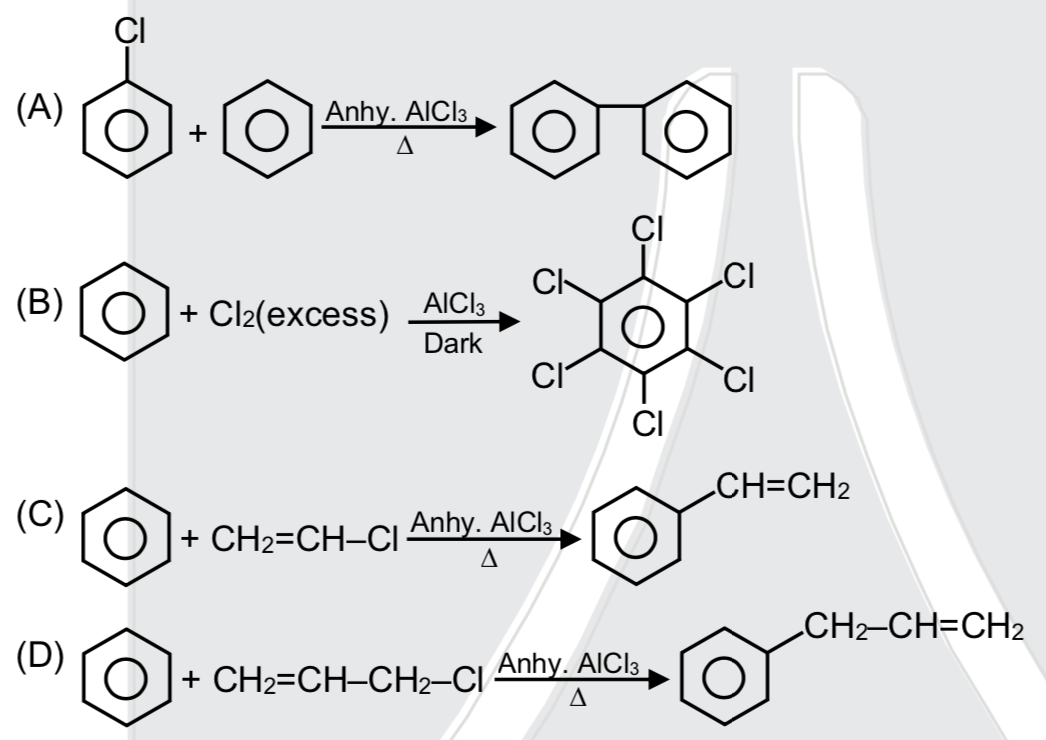Which one of the following is a possible nuclear reaction ?
The correct Answer is:B
To determine which of the given nuclear reactions is possible, we need to analyze each reaction based on the conservation laws of mass, charge, and energy. Here's a step-by-step breakdown of the solution:
Step 1: Understand the Conservation Laws
Nuclear reactions must obey the conservation of:
- Mass Number (total number of nucleons)
- Charge (total charge)
- Energy
Step 2: Analyze Each Reaction
Let's denote the reactions as A, B, C, and D for analysis.
Reaction A:
- Nucleons: 14 (left side) vs. 14 (right side)
- Charge: Not conserved (check the specific charges)
- Conclusion: Not possible due to charge conservation.
Reaction B:
- Nucleons: 239 (left side) vs. 239 (right side)
- Charge: 93 (left side) vs. 93 (right side) (considering beta particle and anti-neutrino)
- Conclusion: Possible as both mass and charge are conserved.
Reaction C:
- Nucleons: 23 + 124 = 147 (left side) vs. 24 (right side)
- Charge: Check if the charge balances (sodium and hydrogen interaction)
- Conclusion: Not possible because sodium does not react with hydrogen in this way.
Reaction D:
- Nucleons: 12 (left side) vs. 12 (right side)
- Charge: Check if the charge balances
- Conclusion: Not possible due to charge conservation.
Step 3: Final Conclusion
After analyzing all reactions, we find that:
- Reaction A: Not possible (charge not conserved)
- Reaction B: Possible (both mass and charge conserved)
- Reaction C: Not possible (sodium does not react with hydrogen this way)
- Reaction D: Not possible (charge not conserved)
Thus, the only possible nuclear reaction is Reaction B.
Nuclear reactions must obey the conservation of:
- Mass Number (total number of nucleons)
- Charge (total charge)
- Energy
Let's denote the reactions as A, B, C, and D for analysis.
- Nucleons: 14 (left side) vs. 14 (right side)
- Charge: Not conserved (check the specific charges)
- Conclusion: Not possible due to charge conservation.
- Nucleons: 239 (left side) vs. 239 (right side)
- Charge: 93 (left side) vs. 93 (right side) (considering beta particle and anti-neutrino)
- Conclusion: Possible as both mass and charge are conserved.
- Nucleons: 23 + 124 = 147 (left side) vs. 24 (right side)
- Charge: Check if the charge balances (sodium and hydrogen interaction)
- Conclusion: Not possible because sodium does not react with hydrogen in this way.
- Nucleons: 12 (left side) vs. 12 (right side)
- Charge: Check if the charge balances
- Conclusion: Not possible due to charge conservation.
After analyzing all reactions, we find that:
- Reaction A: Not possible (charge not conserved)
- Reaction B: Possible (both mass and charge conserved)
- Reaction C: Not possible (sodium does not react with hydrogen this way)
- Reaction D: Not possible (charge not conserved)
Topper's Solved these Questions
- BOOK - A2ZCHAPTER - NUCLEAR PHYSICSEXERCISE - Assertion- Reason10videos
NUCLEAR PHYSICS
- BOOK - A2ZCHAPTER - NUCLEAR PHYSICSEXERCISE - Section D - Chapter End Test29videos
NUCLEAR PHYSICS
- BOOK - A2ZCHAPTER - NUCLEAR PHYSICSEXERCISE - AIPMT/NEET Questions52videos
NUCLEAR PHYSICS
- BOOK - A2ZCHAPTER - MOCK TESTEXERCISE - Mock Test 344videos
MOCK TEST
- BOOK - A2ZCHAPTER - SEMICONDUCTOR ELECTRONICSEXERCISE - EXERCISE29videos
SEMICONDUCTOR ELECTRONICS
Similar Questions
Knowledge Check
- Question 1 - Select One
Which one of the following is the best nuclear fuel?
ANeptunium-239BUranium-235CThorium-232DPlutonium-239 - Question 2 - Select One
Which one of the following is NOT a nuclear power station of India?
AKaplakkamBTarapurCNaroraDPokhran - Question 3 - Select One
Which one of the following is not a nuclear power station of India?
ANaroraBPokhranCKalpakkamDTarapur
Which of the following is correct for a nuclear reaction ?
View SolutionWhich of the following reactions is possible?
View SolutionWhich of the following reactions is possible ?
View SolutionWhich of the following reactions is possible ?
View SolutionWhich of the following reactions is possible ?
View Solution


